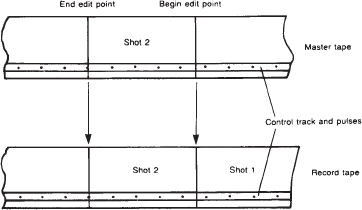Control track counters give more accuracy and speed editing.
Editing Methods — Control Track Counters
A better method is to use a control track counter editing system. As noted earlier in “Other Tracks and Lockup (2),” vertical sync pulses are laid down regularly on the control track to stabilize the tape's playback speed. A control track counter editing system uses these pulses as reference points to simulate and perform edits.
The control track counter is hooked up between the VTRs, although some systems have a counter built in. This editing process begins much as the manual method does. You select edit points on the playback and record machines. However, the editing system usually prerolls the machines for you and offers a preview option. If you select this mode, the system prerolls the machines and starts them, displaying first the output from the record machine (the previous shot) and then, at the correct edit point, switching to the playback machine's output (the current shot). This simulates the edit without actually making it. If the edit was good, you can have the system make the edit that was previewed.
This sounds like a pretty incredible machine, but it operates on a very simple principle. The heart of this editing system, the edit controller, merely counts control track pulses. So once the edit point is chosen, all it does is count pulses. When the controller backs up the machines for preroll, it backs up both machines the same number of pulses, then rolls forward, counting the pulses, until it gets to the original edit points, at which point it makes the edit.
The controller ends the edit in the same way. Based on the end points that you predetermined, the controller measures the duration of the edit by counting the number of pulses. When you finally initiate the edit, the controller can recount the pulses and properly end the edit.
Since the controller is counting control track pulses, control track must be laid down in the areas the controller engages. This is particularly important in assemble editing when you are adding a shot. The control track pulses at the very end of an edit (in the last few frames) may not be of good quality because the controller has already begun to end the edit. If your end point is exactly where you want the edit to end, the next edits in point may be either in an area of poor pulses or where there are no pulses at all. Therefore, when you are assemble editing, always let a scene continue longer than you need to; your next edit still can begin where you want it and you will have good pulses for the in point.
An edit made using a control track system. The system determines the length of the edit by counting control track pulses.

